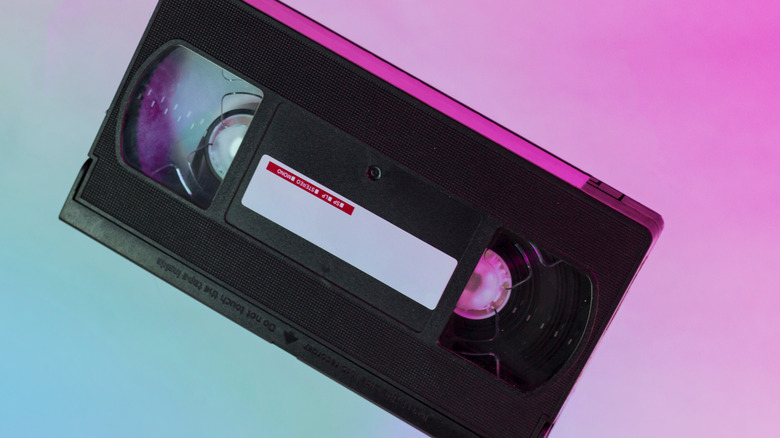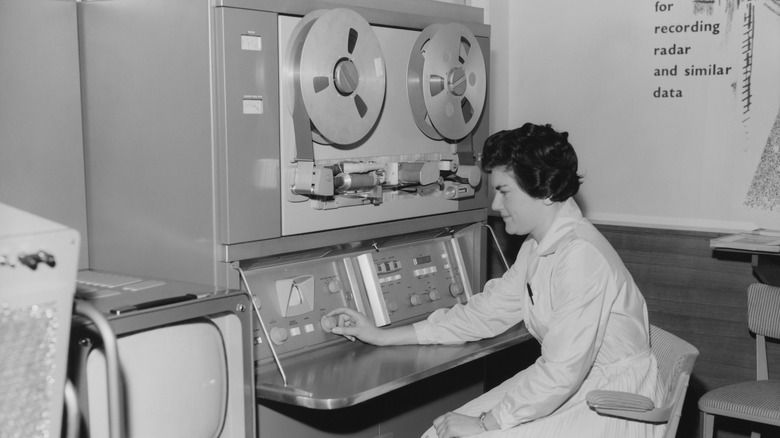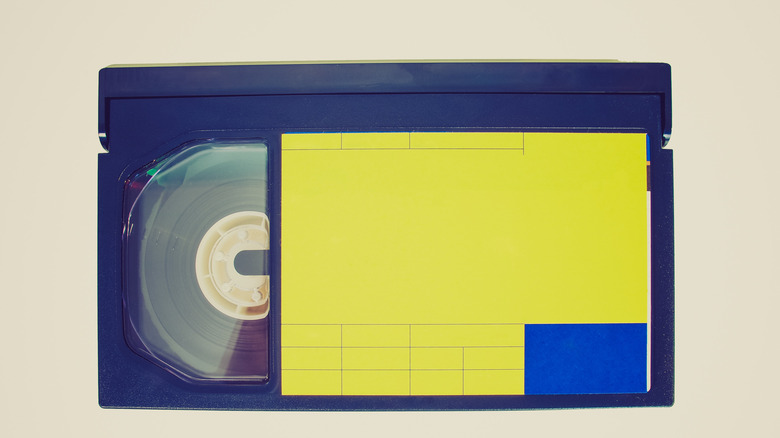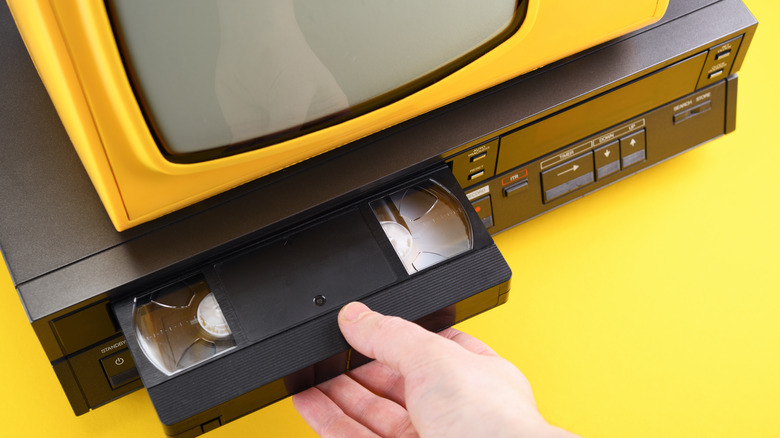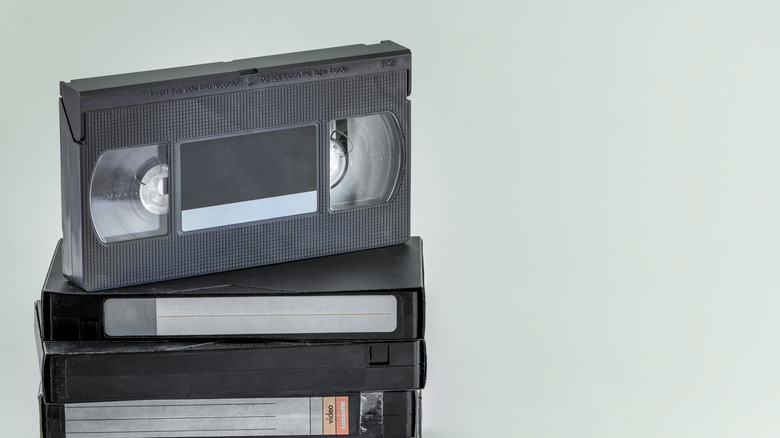The Bizarre Supreme Court Case That Almost Made VHS Tapes Illegal
Few responsibilities made you feel like you had the weight of the world on your shoulders like being asked to record something on TV. Anything. It could be a hockey game, a favorite sitcom, or the 6 o'clock news, forgetting to set a timer or press record meant failure that would undoubtedly be brought up time and time again. "No, we can't trust him to do it. Remember when we asked him to tape 'Seinfeld' and he forgot?"
With VCRs — video cassette recorders — firmly in the rearview mirror of consumer electronics history, it's easy to forget that there was a moment in time when they were on the cutting edge. Being able to record and then watch and re-watch your favorite shows without being stuck to the schedule put forth by the network programming powers that be must have made it seem like flying cars and robots were just a few months away.
But much like with robots, new technology brings with it previously unexplored ethical questions. That's precisely what happened with VCRs. Hollywood studios feared that consumers being able to record things at their whim was a copyright issue that would cut into their bottom line, while companies that manufactured VCRs, as well as VHS and Betamax tapes, were trying to prevent their lucrative products from being outlawed. This led to Sony Corp. of America v. Universal City Studios, Inc. making its way to the United States Supreme Court (via Sound and Vision).
The predecessors of the VCR
VTRs, or videotape recorders, were the precursors to VCRs. Before they came around the only way to record a TV program was with a film camera. According to The Take, this was known as kinescope recording. It consisted of plopping a film camera in front of a monitor and filming the image it displayed. The problem was this method didn't yield a high-quality recording and it wasn't the sort of thing consumers could do in their homes, as it was primarily used by television networks to record and then re-air live-on-tape programs in different time zones.
According to ThoughtCo, Ampex Corporation was the company responsible for developing one of the first VTRs. It was completed in 1951 and was capable of taking information from TV cameras and converting it to a series of electrical signals that were then recorded on magnetic tape. Five years later, the company refined the technology and was offering a VTR for sale. The problem was that with a mid-'50s price tag of $50,000 they were prohibitively expensive. In the 1960s Sony released the CV-2000. It used a reel-to-reel layout, and while the quality wasn't great, they were affordable enough that they found their way into some homes (via Top Ten Reviews). It was another 10 years before bulky, cumbersome tape reels were replaced with the more user-friendly cassettes that VCRs utilized.
The VCR wars ramped up
VCRs debuted in Japan and were in the United States within about a year. While several major companies threw their challengers into the VCR ring, two formats, in particular, gained the most traction. The two were JVC's VHS and Sony's Betamax. Betamax was the first to hit the market, appearing in Sony's native Japan in 1975. According to Sony, as is the case for many new advancements in consumer electronics, it was unclear at the time whether there was much of a market for home video recorders.
JVC's VHS format carried some advantages over Betamax. VHS had a longer run-time than Betamax, according to Top Ten Reviews, and on top of that, they were also cheaper than their main competition. At one point early on, Sony had approached JVC about standardizing their products, but this idea fell through. Betamax and VHS cassettes were different sizes, which meant that compatibility was not possible. This left consumers having to decide which format they wanted to adopt, since the likelihood of people forking over the money for both seemed unlikely.
Film studios took notice of the new technology
While the companies that developed VCRs duked it out for market footholds, film studios were keeping an eye on them with their own concerns. According to the U.S. Copyright Office, both Universal Studios and Walt Disney Productions were becoming increasingly concerned about the new technology. Both studios produced films as well as television programs and their worry was that consumers who purchased and then used VCRs to record their programs were violating copyright laws and infringing on their copyrighted material, which, of course, would cause them to lose money (via Cornell Law School).
Universal Studios decided to seek legal action and took Sony to court. They filed a suit in United States District Court for the Central District of California that alleged that Sony was liable for the alleged copyright violations because they produced the Betamax tapes that were used to record TV shows. Universal's suit only dealt with Sony and had nothing to do with consumers who had purchased Betamax tapes.
Time Shifting became the focus
Anyone who has ever popped in a commercially produced VHS tape, DVD, or Blu-Ray disc has seen the warning that reproducing and re-selling the material is a violation of copyright law. That's not what Sony Corp. of America v. Universal City Studios, Inc. was dealing with, as that issue wasn't up for debate. According to the U.S. Copyright Office, the crux of the case dealt with the legality of what they called time-shifting. This is when a viewer records a program for personal use with the intent of watching it at a later time.
The original suit was filed in California in 1976, but the case bounced around to courts at different levels until it finally appeared before the United States Supreme Court, with initial arguments taking place in 1983, per Cornell Law School.
The Supreme Court's decision was announced in January 1984 and it was a big one for the future of consumer electronics. A ruling in Universal's favor would've spelled the end for both Betamax and VHS tapes. However, the ruling favored Sony, with the Supreme Court deciding that time-shifting did not violate copyright laws and fell under the category of fair use.
The aftermath of the Supreme Court's decision
While it was a major win for Sony because it meant that their Betamax tapes and players could stay on the market, they were falling behind JVC's VHS format. According to Sony, while Betamax tapes were smaller in size and provided higher-quality recordings, their big shortcoming was that their run-times were, well, short. Betamax tapes could only record up to one hour, not long enough to record a sporting event or movie, something that VHS's longer run-times allowed. Eventually, Sony caved and even started producing VHS products in addition to their Betamax lineup.
With the legal hurdle out of the way, VHS tapes continued to reign until — as is the nature of the tech industry — new technology emerged to replace them (via Wired). In the 1990s, DVDs debuted to replace VHS tapes as the new favored form of physical media, but around the same time, digital video recorders (DVRs) also debuted, eliminating the need for physical media for consumers who wanted to record and watch their favorite programming on their own time.
